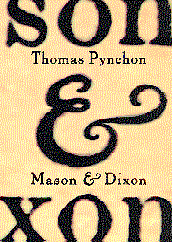Mason & Dixon Press Release
- At January 12, 2021
- By Spermatikos Logos
- In Pynchon, The Modern Word
 0
0

FOR IMMEDIATE RELEASE
With the publication of Thomas Pynchon’s first novel, V., in 1963, one of the most celebrated careers in literary history was launched. When his masterpiece, Gravity’s Rainbow, arrived in 1973, there was widespread agreement that Pynchon ranked among the foremost American writers. Critics, lavishing enthusiastic praise, compared his oeuvre to the work of Melville, Joyce, and Faulkner. In the decades since, the fervor over Pynchon’s writing has continued unabated, spawning an unparalleled flood of discourse and commentary as contradictory and thought-provoking as Pynchon’s novels themselves.
Henry Holt’s April 30 release of Thomas Pynchon’s long-awaited new novel, MASON & DIXON, will undoubtedly elicit further impassioned response as readers and critics are once again confronted with – and challenged by – the power and complexity of Pynchon’s writing.
MASON & DIXON is a re-imagining of the lives of Charles Mason (1728-1786) and Jeremiah Dixon (1733-1779), the British duo best remembered for running the boundary between Pennsylvania and Maryland that we now know as the Mason-Dixon line. Thoroughly dissimilar in temperament and background, Mason – a melancholy, Gothic, citified astronomer – and Dixon, a sanguine, pre-Romantic, rural land surveyor – are first paired on a failed expedition to Sumatra which lands them instead at the Cape of Good Hope, where they observe the rare Transit of Venus, an alignment during which the planet visibly passes across the face of the sun.
Remaining improbably conjoined and loyal for many years, the two banter, bicker, quest and cavort across islands and continents, into realms earthly, celestial, and supernatural. A commission to chart and carve a boundary line takes them to chaotic colonial America. Teeming with a diversity of beliefs, cultures, and split-loyalties – a place more wild than civilized, with more possibility than history – the pre-Revolutionary New World proves particularly fertile soil for Pynchon’s singular imagination.
As Mason and Dixon make their way through inns, taverns, coffeehouses, and establishments of ill-repute – places “congenial to the unmediated newness of history a-transpiring” – they encounter a multifarious case of characters that includes: Ben Franklin; George and Martha Washington; a talking dog; a trio of bodice-ripping Dutch sisters; clocks that converse through their pendula; a Chinese Feng Shui master; and a French chef pursued by an amorous robot duck. The voices of frontier folk, Native Americans, nomads, royal appointees, expatriates, and religious fanatics harmonize in a virtual symphony of gossip, recollection, debate, confession, and confabulation.
Entangled from the start in a melange of motives, in conspiracies both real and imagined, Mason and Dixon experience frequent crises of faith and conscience, believing themselves at the mercy of political, historical, commercial, and otherworldly forces they can neither control nor fully comprehend. But the daring, mismatched pair manage to survive their sojourns, and eventually return to England, where they live out the shadowy yet redemptive turns of their later years.
A consummate wordsmith, capable of exquisite expression and evocation, Pynchon also revels in linguistic playfulness. As precise as poetry, his prose is always rich and often operatic – indeed, many of his characters, without warning, break into hilarious, spontaneous song.
Complex, allusive, and erudite – drawing on what one critic has deemed Pynchon’s “astonishing knowledge of what appears to be everything” – MASON & DIXON is also at turns romping, poignant, and uproariously funny. A brilliant synthesis of fact and fiction, history and fancy – indeed, a challenge to the distinction between the two – the book is both a vivid re-creation of a historical period, with all its latent implications for the future, and a grand philosophical inquiry with forays into: the nature of time, knowledge, and communication; the limits of science and reason; the human compulsion to classify and divide; the terrors of wilderness; the evils of civilization; and the pervasive systems in which we find ourselves hopelessly enmeshed.
Evident in these pages are Thomas Pynchon’s far-reaching intellect, philosophical depth, prodigious imagination, and extraordinary use of language. MASON & DIXON is a wildly ambitious tour-de-force, the product of a writer at the height of his powers that once again substantiates Thomas Pynchon’s reputation as one of the major writers – and minds – of the modern world.
Thomas Pynchon is the author of V., The Crying of Lot 49, Gravity’s Rainbow, Slow Learner, a collection of short stories, and Vineland. He received the National Book Award for Gravity’s Rainbow in 1974.
MASON & DIXON
By Thomas Pynchon
Published by Henry Holt and Co., Inc.
115 West 18th Street
New York, NY 10011
Publication and national laydown date: April 30, 1997
ISBN: 0-8050-3758-6
784 pages $27.50
By Thomas Pynchon
Published by Henry Holt and Co., Inc.
115 West 18th Street
New York, NY 10011
Publication and national laydown date: April 30, 1997
ISBN: 0-8050-3758-6
784 pages $27.50
Last Modified: 7 April 1997
Back to: Mason & Dixon Page
Main Pynchon Page: Spermatikos Logos
Contact: quail(at)shipwrecklibrary(dot)com
Back to: Mason & Dixon Page
Main Pynchon Page: Spermatikos Logos
Contact: quail(at)shipwrecklibrary(dot)com
